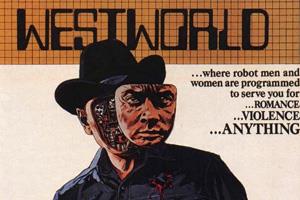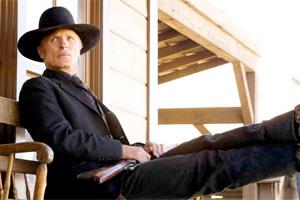“Does Westworld really need another remake?”
A “Mr. Blue” posted that on Twitter just minutes after HBO announced that Jonathan Nolan and J.J. Abrams’ ambitious 10-episode reimagination of Michael Crichton’s 1973 cult film classic is now confirmed for a fall debut.
The original Westworld was set in a futuristic vacation park where every fantasy can come true and nothing can go wrong — or more accurately, as the foreboding narration for the trailer noted at the time, “Nothing can go wr—-o-o-o-o-ng,” followed by static and dead silence.

Crichton directed the film from his own script, which echoed many of the dystopian themes in his early novels The Andromeda Strain and The Terminal Man. Crichton occasionally cited Jules Verne, George Orwell, Mark Twain and Arthur Conan Doyle as formative influences in his decision to become a writer. He was a physician originally, and studied at Harvard Medical School before being driven to write fiction. Not just any fiction but techno-thrillers, prompted by what he saw as widespread abuses in the medical profession. It’s no accident that he was the key inspiration and one of the driving forces behind the long-running hospital drama ER, a series that arguably changed the way TV would treat medical issues from then on.
Westworld told a linear story. A fun-seeking Everyman decides to relive a childhood fantasy as a gunslinger hero in his very own Western, in a high-tech vacation world that can reproduce just about any fantasy, and make it seem real. There’s no danger to the vacationers; the so-called bad guys are animatrons, no more threatening than the shark in the Jaws backlot tour at Universal Studios Hollywood. Except, of course, when things go wrong. . .
Westworld may have told a linear story, but the theme-park setting was home to several different made-up worlds, including a Medieval World, based on the Middle Ages, and a Roman World, set in pre-Christian Pompeii, before the volcano.
Even in 1973, in other words, there was potential for a spin-off TV series. The background setting of multiple worlds lends itself to any number of anthological stories, the lifeblood of series TV. Gene Roddenberry once said that, while developing Star Trek, he knew an idea might work as a TV series if he went home on a Friday night and by Monday morning could come up with anywhere from 25 to 35 workable ideas for self-contained episodes.
The cable model is different: As Fargo and American Horror Story have shown, a single story can sustain a 10-episode miniseries, if it has a richly compelling story, deeply drawn characters and a feature film mind set.
HBO’s Westworld certainly seems to have a feature film feel. The high-octane cast — Anthony Hopkins (left), Ed Harris (below), Evan Rachel Wood (top), Thandie Newton (below), James Marsden (top), Jeffrey Wright (left with Hopkins) and others — coupled with a stylish, visually arresting trailer is an attention grabber.
Does Westworld need another remake?
If anything, in 2016, the premise seems even more timely than it was in 1973, and not just because technology has advanced to the point where anything and everything seems possible.
Virtual-reality fantasies are just around the corner. Driverless cars — now there’s a frightening thought — are about to become a reality, if recent reports are to be believed.
Theme-park goers in the early ‘70s could not have imagined what today’s theme parks can do, both in terms of their gee-whiz factor and their immersive experience.
Westworld has the potential to be a long-running series, if Nolan and his co-writer Lisa Joy find a way to play to the premise’s potential for multiple storylines while making the futuristic technology seem sexy-cool and threatening at the same time.
The larger question — should movies be reimagined as TV series in the first place? — is one that will be asked every year in the days and weeks after the May upfronts. This year, it’s Lethal Weapon, The Exorcist, Taken, Time After Time, Real Genius, reimagined as Pure Genius, and Rocky Horror Picture Show, following on the heels of last season’s misfires Minority Report and Rush Hour, to name just a few. “I’m watching cable for the first time in a while and apparently there’s a 12 Monkeys TV show now?” a Florida film-studies student posted on Twitter earlier this week.
Bewilderment isn’t the only reaction. Following last month’s upfronts, social media was full of comments about the seeming lack of original ideas at the TV studios and major networks.
Studio marketing executives will argue — some already have — that a TV series based on a movie already has built-in name recognition and a ready-made audience. That makes it an easier sell in a cluttered media market that’s grown increasingly risk averse of late, thanks in no small part to shifting audience habits. This is a time of economic certainty for the cable and broadcast networks, especially when most millennials would just as soon download a favorite movie or TV show for free as pay for a cable package.
It’s debatable how many potential viewers may remember a 43-year-old movie in any event, whether it’s Westworld or The Exorcist.
Not all TV series reimagined from movies are created equal. Some of the small screen’s most fondly remembered — and respected — series were based on movie originals, from M*A*S*H and The Odd Couple to, more recently, Friday Night Lights and Parenthood.
One of the small screen’s more clever — and telling — adaptations was the Linda Lavin sitcom Alice, which ran a heady nine seasons from 1976-‘83. Alice was adapted in turn from Martin Scorsese’s 1973 road-trip romcom Alice Doesn’t Live Here Anymore, a film that may remind today’s audiences more of Thelma & Louise than it did a multi-cam, stage-bound sitcom.
Alice is especially instructive because it was inspired by a supporting character who doesn’t appear until late in the original film. The producers created a rich, warmly inventive comedy around that character, and jettisoned everything — about 90 percent of the film — that happened before that. It’s possible to watch Alice today and enjoy it for what it is, without having seen a single frame of Alice Doesn’t Live Here Anymore, let alone know that it won Ellen Burstyn an Oscar for best actress, or that it featured a (very) young Jodie Foster during her watch-me-steal-the-movie phase.

Adapting a movie for the small screen, even for HBO, isn’t all sunshine and light, of course. The pitfalls are many. Viewers who remember the original movie can’t help but compare the two, and the small screen version often comes up short. The characters are less interesting, the actors seem somehow wrong for the part, and the action is less intense. Everything seems bland, bleached of color. Jane Fonda, Lily Tomlin and Dolly Parton in the original 9 to 5 are now suddenly played by Rita Moreno, Valerie Curtin, Rachel Dennison. That doesn’t make Moreno, Curtin or Dennison lesser actors. They simply seem wrong for the part. (The TV 9 to 5 ran for just four episodes, in March and April of 1982.)
TV reinventions aren’t always duds by definition. There’s always an exception to any rule. Tony Randall and Jack Klugman may well have been more suited to a small-screen version of The Odd Couple than Jack Lemmon and Walter Matthau, just as Alan Alda made M*A*S*H his own.
TV’s reimagined Minority Report may have been unwatchable — look, it’s Wilmer Valderrama channeling Tom Cruise! — but it didn’t take viewers long to get the gist. In the end Minority Report lasted just 10 episodes, four fewer than the ill-advised TV reinvention of Logan’s Run in 1977.
And yet, like a phoenix rising from the ashes of the Hollywood studios’ paucity of imagination, Logan’s Run is about to be resurrected once again, this time as a feature film.
Does Westworld need another remake?
It’s not TV, it’s HBO, after all.
Or put another way, the original Westworld didn’t change. We did.